Old Goa is a historical site and city situated on the southern banks of the River Mandovi, within the Tiswadi taluka (Ilhas) of North Goa district, in the Indian state of Goa.

The Convent of Christ is a former Catholic convent in Tomar, Portugal. Originally a 12th-century Templar stronghold, when the order was dissolved in the 14th century the Portuguese branch was turned into the Knights of the Order of Christ, that later supported Portugal's maritime discoveries of the 15th century. The convent and castle complex are a historic and cultural monument and was listed as a UNESCO World Heritage site in 1983.

The Basilica of Bom Jesus is a Catholic basilica located in Goa, in the Konkan region of India. The iconic church is a pilgrimage centre and recognised by UNESCO as a World Heritage Site. The basilica is located in Old Goa, the former capital of Portuguese India, and holds the mortal remains of St Francis Xavier.

The Basilica of Saint Francis of Assisi is the mother church of the Roman Catholic Order of Friars Minor Conventual in Assisi, a town in the Umbria region in central Italy, where Saint Francis was born and died. It is a papal minor basilica and one of the most important places of Christian pilgrimage in Italy. With its accompanying friary, Sacro Convento, the basilica is a distinctive landmark to those approaching Assisi. It has been a UNESCO World Heritage Site since 2000.

Saint Joseph's Church is a Roman Catholic church in Singapore. It is located along Victoria Street in the Rochor Planning Area, within the Central Area of Singapore's central business district. The church was constructed from 1906 to 1912 with its foundation stone laid in 1904. The building was built in the Neo-Manueline Portuguese late-Gothic style by the Portuguese Mission. Saint Joseph's Church is noted for its Portuguese-inspired religious traditions, such as the annual Good Friday celebrations.
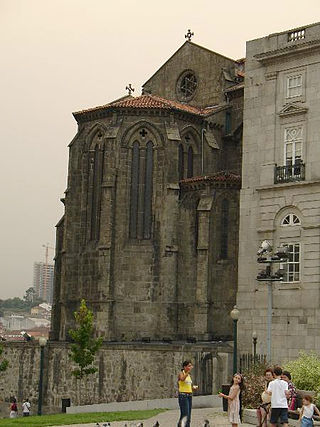
The Church of Saint Francis is the most prominent Gothic monument in Porto, Portugal, being also noted for its outstanding Baroque inner decoration. It is located in the historic centre of the city, declared World Heritage Site by UNESCO.

The Church of St. Anne is a church and religious monument located in the Santana district of Old Goa, in Goa province, India. The 17th century church is a major example of the colonial Portuguese Baroque architecture built in Portuguese India.
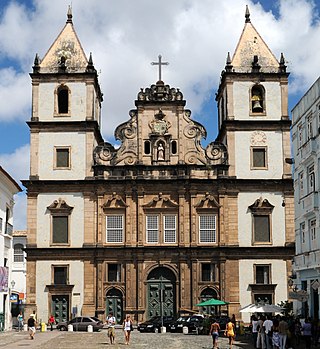
The São Francisco Church and Convent of Salvador is located in the historical centre of Salvador, in the State of Bahia, Brazil. The ornate Church of the Third Order of Saint Francis sits adjacent to the convent. The friars of the Franciscan Order arrived in Salvador in 1587 and constructed a convent and church on the site. This structure was destroyed by the Dutch during the Dutch invasions of Bahia in the next century; Father Vicente das Chagas initiated the current structure in 1686, which was completed in the 18th century. The Franciscan church and convent have the largest number of azulejos, 55,000, of any church in Latin America.

The Our Lady of the Immaculate Conception Church is located in Panjim, Goa, India. The Church conducts Mass every day in English, Konkani, and Portuguese.

The St. Paul’s Church, is situated on Diu Island, on the west coast of India, a Union Territory of India. Diu came under the control of Portuguese colonists in early 16th century.
St Estevam is an estuarine islet in the Tiswadi taluka, Goa state, India. St Estevam is commonly referred as Jūvã (Isle) and has earned the monicker Šākêchô Jūvõ—the island of vegetables—famed for its long, seven-ridged, light green ladyfingers. Therefore, the people of Jūvã came to be nicknamed bhennddem. The island is named after St. Stephen. It is one of Goa's most prosperous villages, often quoted by ex-Chief Minister Pratapsingh Rane for having a high per capita income.
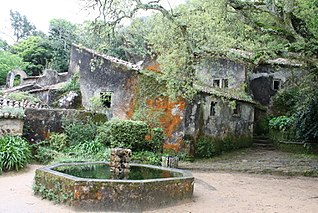
The Convent of the Friars Minor Capuchin, popularly known as the Convent of the Capuchos, but officially the Convento da Santa Cruz da Serra de Sintra, is a historical convent consisting of small quarters and public spaces located in the civil parish of São Pedro de Penaferrim, in Sintra Municipality, Portugal. Its creation was associated with the Portuguese Viceroy of India, D. João de Castro, and his family, but became a pious community of reclusive clergy that continued to occupy cramped humble spaces in the complex until the religious orders were abolished in Portugal.
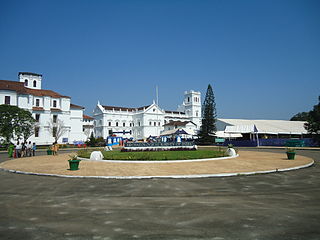
Archaeological Museum and Portrait Gallery was set up in 1964, NS reorganised in 1981–82. It is run by the Government of India's Archaeological Survey of India and is situated in the former Portuguese colonial capital of Old Goa, a historic one-time city which now attracts a large number of tourists.

The convent of Saint Agnes is situated on the right bank of Vltava, in Prague Old Town area called „Na Františku“. The monastery of Poor Clares of the Order of Saint Clare and Franciscans was founded in 1231 by Agnes of Bohemia, who also became the abbess of the convent.

Churches and Convents of Goa is the name given by UNESCO to a set of religious monuments located in Goa Velha, in the state of Goa, India, which were declared a World Heritage Site in 1986.

St. Cajetan Church, also known as the Church of Divine Providence, is a church of the Roman Catholic Archdiocese of Goa and Daman located in Old Goa. The church was completed in 1661 and is part of the World Heritage Site, Churches and convents of Goa.
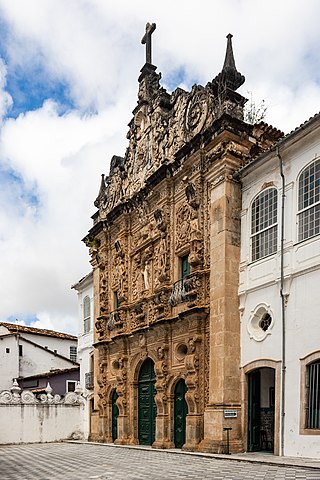
The Church of the Third Order of Saint Francis is an 18th-century Roman Catholic church in Salvador, Bahia, Brazil and seat of the Third Order of Saint Francis in Brazil. The church is one of the main elements of the Historic Center of Salvador and lies within the UNESCO World Heritage Site of the city. It was listed as a historic structure by National Institute of Historic and Artistic Heritage (IPHAN) in 1941. The church was constructed as an annex to the São Francisco Church and Convent. It is noted for its distinctive Plateresque-style façade, an example unique in Brazil. The writer Jorge Amado called the façade of the Third Order church "magnificent."

The Church of Our Lady of the Rosary is a Catholic church built between 1544 and 1547, in Old Goa, State of Goa, India. This church is part of the collection belonging to the World Heritage Site of churches and convents of Goa.

The Chapel of St. Catherine is a UNESCO World Heritage Site located in Old Goa in the same compound as Se Cathedral and the Church and Convent of St. Francis of Assisi. It was built in 1510 in the Baroque architectural style, and has a brown and white facade. It faces the Mandovi River and is part of the World Heritage Site, Churches and convents of Goa. The chapel is not functional.

Basilicas are Catholic church buildings that have a designation, conferring special privileges, given by the Pope. Basilicas are distinguished for ceremonial purposes from other churches. The building need not be a basilica in the architectural sense. Basilicas are either major basilicas, of which there are four, all in the Diocese of Rome, or minor basilicas, of which there were 1,810 worldwide as of 2019.



















